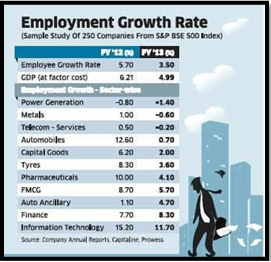A CONVOLUTED APPROACH TO JOB CREATION: ANALYZING INDIA’S EMPLOYMENT STRATEGY
Syllabus:
- GS-3- Employment sceneario in India ,economic slowdown and global challenges, Job creation , skilling youth
Focus :
- This article examines India’s current employment generation strategies, focusing on government incentives like wage subsidies and skill development It critiques these approaches for their disconnect with ground realities and proposes alternative measures to address the unemployment crisis more effectively.
Source - IE
Introduction
- Employment is a critical link. The link between economic output and gainful employment has become increasingly
- The Economic Survey emphasizes the importance of both the quantity and quality of Employment is a critical link between economic growth and
- The link between economic output and gainful employment has become increasingly Current Employment Scenario in India
- Factory jobs in manufacturing grew by only 32 lakh between 2000-01 and 2021-22.
- Tamil Nadu, Gujarat, and Maharashtra account for 40% of total factory sector employment.
- A reduction of 16.45 lakh jobs in unincorporated non- agricultural establishments between 2015-16 and 2022-23.
- As of 2022-23, over 57% of the workforce is self-employed with average monthly earnings of ₹13,347.
- 18% of the workforce are unpaid workers in household
- Workforce engaged in agriculture increased from 44% in 2017-18 to 46% in 2022-23.
- The economy needs to generate nearly 5 lakh non-farm jobs annually until 2030. Government’s Approach to Employment Generation
- The Finance Minister has introduced several employment- linked incentive schemes.
- Schemes include providing the first month’s wage for new EPFO- registered employees and wage subsidies for first-time employees in the manufacturing
- Another scheme offers reimbursements to employers providing additional
- Outlay of ₹12 lakh crore over five years under the Prime Minister’s Package for Employment and Skill
- Aims to meet the annual non-farm job requirement in the next Critique of Supply-Side Incentives
- These strategies presume that labor demand in the non- agriculture sector is sufficient to absorb 50 lakh first-time employees
- The belief that wage subsidies and skill development alone will expand payroll employment is
- Short-term job creation under these schemes is unlikely to sustain beyond the subsidy
- Potential issues include large-scale job shedding in the medium run and misuse of EPFO enrollment for siphoning off public Flaws in Government’s Economic Assumptions
- Over-reliance on the accuracy of official GDP estimates, which have been questioned by
- The discrepancy between GDP growth rates and actual inflation figures highlights issues with economic assessments.
- Economic growth in recent years has been driven by fiscal stimulus, not private sector
- The reduction in fiscal deficit and supply-side incentives are presumed to spur a virtuous investment cycle led by private corporations, which may not hold Alternative Strategies for Employment Generation
Expansion of MGNREGA:
- Extend the Mahatma Gandhi National Rural Employment Guarantee Act (MGNREGA) to urban
- Increase the entitlement beyond 100 days to provide more work
Capital Expenditure in Labour- Intensive Sectors:
- Increase capital expenditure by profit-making Central Public Sector Enterprises (CPSEs) in labor-intensive
- Focus on infrastructure projects that can generate substantial
Promotion of MSMEs:
- Provide financial and logistical support to Micro, Small and Medium Enterprises (MSMEs).
- Encourage startups and entrepreneurship through favorable policies and access to
Vocational Training and Education:
- Enhance vocational training and education to align with market
- Partner with private industries to design curriculum and provide on- the-job
Rural Development Programs:
- Invest in rural development programs to reduce the migration of workers to urban
- Promote agricultural productivity and allied sectors like agro-processing and rural Case Study: Effectiveness of Direct Employment Programs
- Analyze successful direct employment programs globally and their impact on local
- Case studies from countries like Brazil (Bolsa Família), South Africa (Expanded Public Works Programme), and the United States (New Deal programs) can provide insights.
Conclusion
- The government’s current strategy of incentivizing private sector employment through wage subsidies and skill development reflects a dogmatic
- There is a need for a more grounded approach that directly addresses the realities of the labor
- Alternative strategies such as expanding MGNREGA, increasing capital expenditure in labor-intensive sectors, and promoting MSMEs can provide more sustainable solutions to the unemployment crisis in
- A comprehensive and integrated approach is essential to create meaningful and long-lasting employment opportunities for the growing workforce.
Mains UPSC Question:
“Critically evaluate the effectiveness of supply-side incentives in addressing the unemployment crisis in Discuss alternative strategies that could be adopted to generate sustainable employment opportunities.” (250 words)
Source:The Indian express
Associated article
https://universalinstitutions.com/jobs- still/




